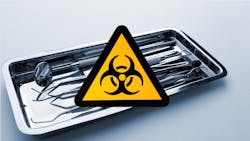You're probably transporting your instruments the wrong way
While working as a part-time server to help pay for dental hygiene school, I was trained to shout specific words or phrases whenever I was carrying something to alert others and avoid bumping into anyone with a tray of hot or dirty dishes. For example, I would say "hot food, corner" or "hot coffee, behind," which prevented mishaps, spillage, or food waste.
I was so used to doing this that I brought it into my hygiene program! When I was carting any dirty, sharp instruments, I would say "behind" to indicate that I was walking with potentially hazardous object behind someone. This made perfect sense to me because the last thing I wanted was to poke them with the instruments I had just used to debride a 6 mm infected pocket. But my faculty felt that I didn't need to say that, and I didn’t fight it since I had to admit that yelling out "corner" in a quiet dental facility was possibly not appropriate.
Two decades later, I now know that we should be transferring our dirty instruments in leakproof, puncture-resistant containers that lock, so if we trip or turn the corner and run into a colleague or, even worse, a patient, we limit danger since our instruments are safely contained.
Also by Michelle Strange:
Could you be the infection control coordinator at your practice?
Is your practice overlooking this important IC step?
Dental offices, schools, and institutions have long struggled with the logistics of moving dental instruments from one location to another, even as we need to maintain complete segregation of clean, dirty, and sterile materials at all times. Environmental contamination, including blood and other bodily fluids, must be avoided when transporting clean instruments and equipment. Meanwhile, used items should be transported in a way that doesn’t contaminate the environment or put anyone's well-being in jeopardy, such as by causing exposure to sharp instruments.
Determining proper transportation of dental instruments and finding the best course of action for your practice is a good infection control measure to safeguard the well-being of your team and your patients. Here, we'll discuss this OSHA requirement and CDC recommendation that many dental providers fail to follow. Spoiler alert: instrument cassettes alone are not going to cut it.
Regulatory standards for transporting contaminated instruments
Guidelines for Infection Control (2003) from the Centers for Disease Control and Prevention (CDC) recommend that every dental office establish site-specific guidelines and standards for transporting contaminated or used instruments and equipment.1 Dental health-care providers are at risk of exposure from contaminated instruments that may contain hazardous materials such as potentially infectious, disease-causing microorganisms through contact with nonintact skin on the hands, contact with mucous membranes, and percutaneous injury from exposure to sharp instruments.
Under the Occupational Safety and Health Administration (OSHA) Bloodborne Pathogen Standard, all contaminated reusable sharps must be immediately kept in appropriate, labeled containers after each use until they can be reprocessed appropriately.2 The Standard also specifies that the suitable container must be resistant to punctures and leakproof from all sides and bottom, and have clear labels or color-coded markings as biohazards. Additionally, to limit employee exposure to hazardous materials, the containers should be sealable.
Best practices for transporting dental instruments
Most dental offices use cassettes to store contaminated instruments after use and then transport them loosely on a bracket tray to and from the processing room. These approaches do not satisfy OSHA's criteria for the safe transportation of contaminated instruments, nor do they adequately protect employees from possible sharps injuries or exposure to bloodborne pathogens. Although generally there isn't much distance to travel from the treatment room to the processing area in an average dental facility, accidents and injuries are more apt to happen if instruments are simply carried in hand or on an open tray.
The first step in ensuring safe instrument handling is to reduce posttreatment handling of sharp and contaminated instruments to minimize the risk of percutaneous injuries. When handling contaminated objects, wear appropriate personal protective equipment (PPE) such as protective clothing, gloves, eyewear, masks, and head and shoe covers. Used instruments should also be stored in appropriate containers at the point of use to prevent injuries during transport from the treatment room to the instrument processing area.
There are several options to keep contaminated instruments safely enclosed while transporting them that also align with advice from the CDC and OSHA. The most secure and safest way is to utilize any OSHA-compliant container. If you’re currently using bracket trays, look for snap-on lids to prevent instruments from falling off the tray and clearly identify them with a biohazard label if used to move contaminated items. Remember to change the stickers regularly as they get worn out. There are also commercially available red biohazard containers that don’t require labeling, as these are automatically recognized as holding biohazardous material by their color.
For transporting larger or numerous items, there are various options for closed carts suitable for moving sealed containers of soiled instruments from treatment rooms to the reprocessing areas.
Although there is usually only a very short distance for transporting contaminated instruments from the operatory to the sterilization center, this does not negate the need for adhering to infection control measures. Whether you choose to implement an infection protocol yourself or seek the advice of an infection control coordinator to find best practices for your clinic, doing so will improve the overall safety of your office. Your clinic will also be in compliance with CDC and OSHA safety recommendations, which means that you’ll uphold a level of quality that assures the safety of your team and patients.
Editor's note: This article appeared in the June 2022 print edition of RDH magazine and has been updated as of May 2025. Dental hygienists in North America are eligible for a complimentary print subscription. Sign up here.
References
1. Kohn WG, Collins AS, Cleveland JL, et al. Guidelines for infection control in dental health-care settings—2003. MMWR Recomm Rep. 2003;52(RR-17);1-61.
2. Bloodborne pathogens. Standard: 1910.1030. Occupational Safety and Health Administration. United States Department of Labor. Accessed January 31, 2022. https://www.osha.gov/laws-regs/regulations/standardnumber/1910/1910.1030
About the Author
Michelle Strange, RDH
Michelle Strange, RDH, is a dedicated dental hygienist and educator passionate about infection control and patient safety. With over 20 years of experience in clinical practice, Michelle is committed to sharing evidence-based solutions to improve dental care outcomes.

